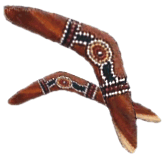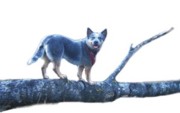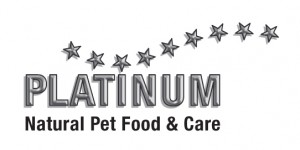History | Standard | Health
HEALTH
Although Australian cattle dog is relatively healthy breed, it’s common for breedersto test their dogs for Hip and elbow dysplasia, PRA prcd, and deafness.
HIP DYSPLASIA CHD Canine Hip Dysplasia
Canine Hip Dysplasia simply means improper growth or development of the canine hip joint. This improper growth is usually characterized by lax or loose hips, which allows excessive movement in the hip joint which in turn leads to arthritis and lameness. Dogs that are afflicted with CHD can have problems with going up or down stairs, difficulty in rising, a bunny-hopping gait when walking or running, early morning stiffness, personality changes from the pain, a wobbly gait, or lameness after exercise. Dogs often will carry more of their weight on their front egs as a result of the pain in the hips, resulting in the front end of these dogs being better developed than the rear. It is possible for a dog to have CHD yet have no signs of the disease or for the disease to become so severe that the dog can not use it rear legs.
The only way to correctly diagnose CHD is to have a radiographic (X-ray) examination performed by a veterinarian.
Both heredity and environmental factors are important in the development of CHD. Enviromental factors beeing - if exercised too strongly early in life and/or are fed diets that are too high in calories and protein. Diets that are low in protein combined with low activity levels markedly reduced the severity of CHD in animals that were genetically predisposed to developing this condition.CHD is inherited as a polygenetic trait. In other words, many genes are involved. Dogs have two copies of each gene that controls CHD (the total number of genes
that control or contribute to the development of CHD is unknown; but it is believed that many are involved). They get one gene from their mother and the other from their father. Some of the "good genes" are dominant over the recessive "bad genes".hus, the physical expression of the "good genes" will be result in good hips, even though the animal is carrying a number of hidden (recessive) "bad genes". If the bad recessive genes line up incorrectly then more of the puppies could have hip dysplasia.
However, if the good dominate genes line up well then many of the pups will have good hips, but may still carry the hidden bad genes. Complicating the situation even further is that some genes may be good when combined with one set of genes and bad when combined with different set of genes. It is also possible for some genes to have a greater or lesser influence on CHD than others, adding to the complexity of the problem.
However, it is OFA's (Orthopedic Foundation for Animals) opinion, that a dog with fair hips and less than 25% of its littermates exhibiting dysplasia is a better breeding prospect than a dog with excellent hips having more than 25% of its brothers and sisters affected by hip dysplasia. In other words, less of the bad genes are likely to be present where a smaller percentage of the littermates have CHD.
To eliminate the bad hidden (recessive) genes from the pool can be achieved by careful line breeding, making good hips part of that line's type.It is also important to point out that a good dog is more than just good hips. The treatment options available to help dogs that are suffering from CHD range from drug therapy to relieve pain to total hip replacement.
References : Canine Hip Dysplasiaby Tom Phillips, D.V.M., MS, PhD.
ELBOW DYSPLASIA OCD Osteochondrosis
Current theory on elbow dysplasia holds that all problems are caused by asyncronous growth of the bones. It is a relatively common and painful congenital bone defect disease that is characterized by abnormal cartilage-to-bone transformation, which causes cartilage and bone fragments to break off into your dog’s joint space, which, in turn, causes mild to extremely severe discomfort and pain. Cartilage is the bone tissue that contributes to pain-free motion.
Osteochondrosis isn’t a form of arthritis, although it can and often does lead toarthritis. Larger breeds of dog have a genetic predisposition towards the condition, which generally results from rapid growth. According to one study (Swedish and Australian studies (digest 654)) that
showed OCD to have a higher heritability factor than hip dysplasia.
ROGRESSIVE RETINAL ATROPHY PRA
P.R.A.is an inherited disorder that effects the retina of the eye. In most of the breeds it is inherited as a recessive trait.
The first stage of the disease is the degeneration of the “rod” cells, the cells in the back of the eye, which causes night blindness. This is followed by loss of function of the “cone” cells which means the eyes no longer function even in full light conditions. The lens of the eyes may become cloudy, or opaque, resulting in a cataract. The big difference in PRA among breeds is in the age of onset and the rate of progression of the disease. ACDs have been diagnosed with prcd-PRA over a very wide age range – as young as 3 years and through 8 years or older. Although the typical age of diagnosis is 4 to 6 years.
Every dog has 2 genes for PRA, only one gene from each parent is passed onto each pup, but not necessarily the same gene to each pup. The most reliable test for PRA is a DNA blood test that will tell you if your dog’s genotype : A - normal (does not carry the gene), B - carrier (carries the gene, but will not develop PRA over it's lifetime), or C- an affected (means carries the disease and will develop blindness over it's lifetime).
O being a clear gene and X being an affected gene.
Pattern A - Clear = OO
Pattern B - Carrier = OX
Pattern C – Affected = XX
Matings:
Pattern A + Pattern A = all pups will be Pattern A (Clear)
Pattern C + Patttern C = all pups will be Pattern C (Affected)
Pattern A + Pattern C = all pups will be Pattern B (Carriers)
Pattern A + Pattern B = pups might be Pattern A or B (Clear or Carriers)
Pattern C + Pattern B = pups might be Pattern C or B (Affected or Carriers)
Pattern B + Pattern B = pups might be Pattern A or B or C (Clear, Carriers or Affected)
Carrier and Affected dogs can be mated very successfully with Pattern A dogs, but they shouldn’t be mated with Pattern B or C’s as the percentage of the Affected pups in the litter can’t be predicted!





